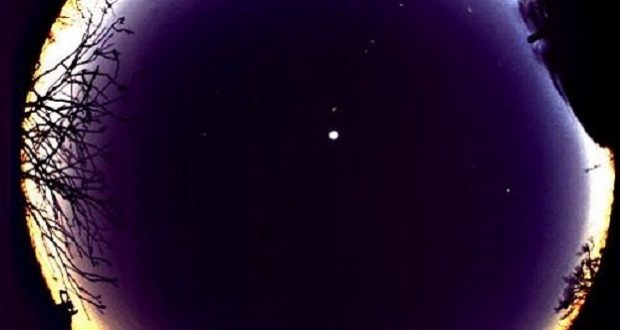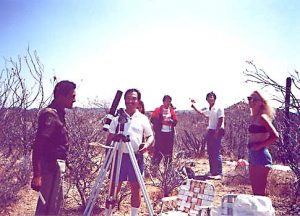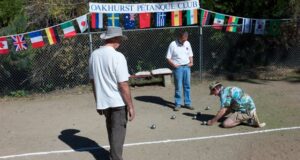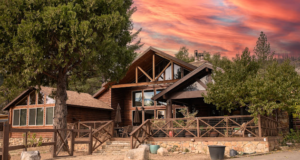Greetings Earthlings. This is to notify you that at noontime on August 21 along a 70 mile wide path extending from Oregon to South Carolina, sunlight will be unavailable for about two-and-a-half minutes. Do not panic, this is a scheduled outage. In fact, it has been scheduled for millions of years. If you are not in the path you will notice nothing unusual and will live the rest of your life in regret and self-pity without the benefit of having experienced this rare phenomenon.
Well, okay, so here’s another, lighter approach to convince you why you should see the total eclipse on Monday, Aug. 21.
In July 1991, I was living in Monterey, California. On whim, I and then-wife Ingrid decided to drive the 1,500 miles from Monterey to the tip of Baja to view the total eclipse on July 11 that year.
This was to be a big deal and the Mexican government expected problems accommodating the anticipated large crowds. In order to cross the border between Baja North and Baja South you needed to show proof of lodging reservations. There were gas trucks positioned along the highway so you could purchase gas directly from the truck in the event of shortages.
Possibly as a result of all this publicity, the expected crowds never materialized and we had the highways pretty much to ourselves. For much of the distance we leapfrogged through the spectacular desert landscape with an aging surfer dude in a pink ’72 El Dorado convertible with a cooler of beer strapped in the passenger seat.
We arrived the day before and spent a day exploring and scouting out the best location on the path centerline, which crossed the Baja Peninsula from west to east roughly halfway between La Paz and Cabo San Lucas.
We found a place on a cactus-covered knoll about 100-yards off the highway. The next morning, we arrived about two hours before the start of the eclipse and set up a small telescope, our chairs and cooler on the knoll.
To the east we could see the Gulf of California and to the west the Pacific Ocean. We were eventually joined by a couple from Chile, two Japanese guys festooned in camera gear and a Mexican Federale who was pretending to be out of radio contact so he could see the eclipse while having a beer with us.
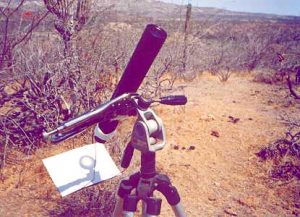 We had set up our small telescope with a piece of paper which served as a screen on which to project the sun’s image. Then we milled about, drinking beer, chatting in English, Spanish, Japanese and Swedish. Multi-language conversation was difficult so we mostly just drank beer and watched sunspots on the screen.
We had set up our small telescope with a piece of paper which served as a screen on which to project the sun’s image. Then we milled about, drinking beer, chatting in English, Spanish, Japanese and Swedish. Multi-language conversation was difficult so we mostly just drank beer and watched sunspots on the screen.
As first contact approached, we gathered around the scope. This was maybe the most exciting part of the event. Intellectually, you know that these events can be calculated with micro-second precision thousands of years in advance. So, you know with intellectual certainty that this weird event will happen and exactly when.
Yet, emotionally you are less certain. This day seems like any other: the birds are singing, flies are buzzing and the sun is shining as it always does in the middle of Baja in the middle of the day in the middle of July and it’s difficult to imagine that at exactly 10:46:52 … the sun will begin to go … dark?
We gathered at the scope and then, at exactly 10:46:52, a slight disturbance could be seen nibbling at the edge of the sun. An event that could have been calculated a million years ago — was actually beginning! Over the course of the next hour we watched on the screen as the Sun’s disk was progressively covered by the moon.
Until the sun was about 90 percent covered, there was no visible effect. This is important because some people believe, erroneously, that a 90 percent partial eclipse is about 90 percent as good as a 100 percent, or total, eclipse. Not true. It’s essentially an all or nothing proposition. If you’re not in the 70-mile wide path of 100 percent totality you will see very little visible difference from a normal day.
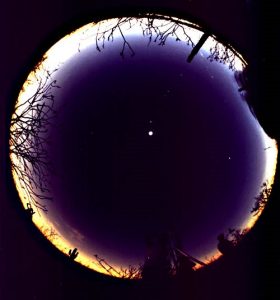 At about 10 minutes before totality, things start to visibly change. Light starts becoming dimmer and takes on an eerie flat tone. Shadows on the ground, normally diffuse, become sharp. The shadows of the cactus around us appeared as if photographically imprinted on the ground. Some colors began to glow with strange vividness.
At about 10 minutes before totality, things start to visibly change. Light starts becoming dimmer and takes on an eerie flat tone. Shadows on the ground, normally diffuse, become sharp. The shadows of the cactus around us appeared as if photographically imprinted on the ground. Some colors began to glow with strange vividness.
The woman from Chile was wearing a shirt that was a normal red color. Her shirt began to glow an almost neon red. About three minutes before totality we could notice shadow bands skittering across the sand. Appearing as waves in a liquid desert, they darted in all directions. There were cattle in a nearby pasture who began making anxious noises and some birds started some confused-sounding tweeting.
It was now about one minute to totality and it was becoming dark fast. The air temperature, 100 degrees several minutes before, was now dropping by the second. Dark surfaces, such as the telescope hardware, were becoming chilled as they radiated their heat out into dark space.
About 10 seconds before totality we looked to the west and saw a monstrous black shape rising up out of the ocean. It consumed some clouds on the horizon and the blue sky as it rose up towards the sun. It was the moon’s shadow racing at us at about 700 miles per hour. An instant before the shadow reached it, I looked directly at the sun. You’re not really supposed to do this, so timing is critical.
For an instant, the remainders of the sun appeared as a semi-circle of pearls. This effect is called “Bailey Beads” and the “pearls” are the last vestiges of sunlight shining through the passes of the mountains of the moon! And then — totality.
Now, everyone can look directly at the sun without equipment. Being about noontime, the eclipse was at the zenith (top) of the sky dome. The sky was now completely dark and all the stars were visible. All around the 360-degree horizon was a bright orange band of the sunset/sunrise. I had expected to see a black disk with yellow flames around it as is the traditional depiction, but it was nothing like that.
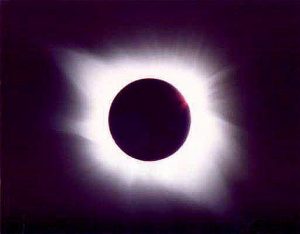 The corona was pure white, sharply focused and extended outward several diameters from the sun. It was so sharply focused that it appeared much closer. In fact, the entire spectacle at this point gave the impression of happening right in front of your face and not millions of miles out in space.
The corona was pure white, sharply focused and extended outward several diameters from the sun. It was so sharply focused that it appeared much closer. In fact, the entire spectacle at this point gave the impression of happening right in front of your face and not millions of miles out in space.
We were witnessing something that had altered history and religion. We were seeing something exactly as it had been seen by dinosaurs. It was stark, eerie and hypnotic. Then, after several minutes the sun emerged from behind the moon and over the next hour the entire sequence repeated in reverse until the universe was back to comfortable normalcy.
In July 1991, it was not certain that we’d even make the long trip to Baja but now, looking back, it’s unimaginable that we would have missed it. And that’s why you should see the eclipse on August 21.
There is much information easily found online about the August 21 Total Eclipse so I’ll make just a few points:
- Don’t confuse solar and lunar eclipses. A total solar eclipse and a total lunar eclipse are entirely different things. Lunar eclipses are relatively frequent and are not particularly dramatic. In contrast, total solar eclipses at any point on the earth are extremely rare and extremely dramatic. The last eclipse to traverse the entire U.S. was in 1918.
- As mentioned before, it’s all or nothing. To view the phenomenon you must be within the path of the 100 percent totality. For example, if you are in the path of 90 percent totality you will NOT experience a 90 percent eclipse – you will essentially experience nothing. The path of totality is about 70 miles wide but it is best to locate as close as possible to the centerline. There are many online maps.
- No special equipment such as a telescope or binoculars are required or recommended. A cheap welders glass ($4) or “Eclipse Glasses” ($4) or pinhole box is only necessary to view the sun immediately before and after totality. You do not need and should not use eye protection during totality, when the disk of the moon completely covers the disk of the sun — about 2.5 minutes. Eclipse glasses and safety information are widely available online.
- There will be plenty of astronomical gear guys with all sorts of sophisticated equipment and they are always happy to let you view through it.
- Accommodations along the way likely become unavailable soon, especially as the event begins to appear in the media. Motel 6 rooms in Jackson, Wyoming, sold out at $500 per night. Camping or traveling into the eclipse zone on eclipse day will then be the only — but entirely feasible — option.
- If you’re traveling in to the shadow zone, be familiar with the roads as weather and clouds may require last minute shifts in location. If the whole thing happens behind the only cloud in the sky, you’ll be really, uh… annoyed.
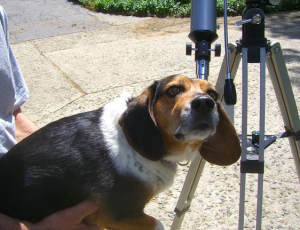 We’ll be traveling to Idaho to view the event from Menan Butte — a huge extinct volcanic cinder cone southwest of Rexburg. We expect plenty of company up there with people doing things from scientific to strange.
We’ll be traveling to Idaho to view the event from Menan Butte — a huge extinct volcanic cinder cone southwest of Rexburg. We expect plenty of company up there with people doing things from scientific to strange.
I wonder if our little Beagle, Trumpet, will howl? He’ll probably just try to figure out if he’s looking at something edible. Either way, it will be very cool, indeed. I’ll report back several hours later.
Read about Bob Kaspar’s epic solo-cycle from California to Massachusetts.

